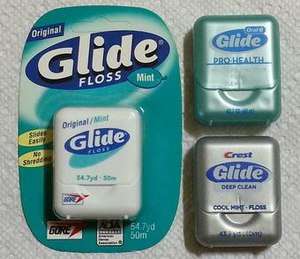Oral-B Glide
Oral-B Glide is a polytetrafluoroethylene (Teflon) dental floss manufactured by W. L. Gore and Associates exclusively for Procter & Gamble.

History
Origin
The origin of Glide (which is what the brand was called prior to the P&G acquisition) dates to 1971, when Bill Gore first used a Gore-Tex fiber to floss his own teeth;[1] Gore-Tex was the PTFE-based fiber he had invented as a "waterproof laminate." The company failed to market the product for more than three decades. Ultimately, it succeeded by marketing to dentists rather than selling the floss as a consumer product. It was widely adopted, and grew to be the #1 brand of floss in dental office use, and #2 floss in retail.[1]
Sale to Procter & Gamble
In September 2003, Gore sold the brand to Procter & Gamble, who at the time announced its intention to brand the product under the Crest product line.[2] The terms of the sale provided that Gore would continue to manufacture and develop the product.[3] In 2010, Procter & Gamble rebranded the product as Oral-B Glide.
Popularity and sales
In 2006, Crest Glide was the second-ranked brand of dental floss in the United States, with sales (in supermarkets and drug stores) of $22 million and a market share of 18.8%, just behind Johnson & Johnson Reach.[4]
Environmental and Health Concerns
Environmentalists have recommended non-PTFE brands, discouraging the use of the environmentally unfriendly Teflon.[5] There is also a health concern given the use of Perfluorooctanoic acid, a possible carcinogen, in the making of Teflon.[6] A 2019 study showed that some women who had flossed with Glide had elevated levels of perfluorohexanesulfonic acid (PFHxS) in their blood compared to non-flossers, and fluorine compounds were identified in Glide (as well as 5 other brands of floss out of 18 brands tested).[7] Procter & Gamble, however, disputes this finding.[8] "The study, led by Silent Spring Institute in collaboration with the Public Health Institute in Berkeley, CA, appears online ... in the Journal of Exposure Science & Environmental Epidemiology (JESEE), and is part of a special issue dedicated to PFAS (per- and polyfluoroalkyl substances)."[9]
See also
References
- Thatchenkery, Tojo; Metzker, Carol (2006). Appreciative intelligence: seeing the mighty oak in the acorn. San Francisco, California: Berrett-Koehler Publishers. p. 18. ISBN 978-1-57675-353-8.
- Ellison, Sarah (September 17, 2003). "P&G Is to Buy Glide Dental Floss, A Popular Brand". The Wall Street Journal.
- "Procter & Gamble to buy Glide floss business". Reuters. September 17, 2003.
- Lazich, Robert S. (2007). Market Share Reporter 2007: An Annual Compilation of Reported Market Share Data on Companies, Products, and Services. Detroit, Michigan: Gale Group. p. 309. ISBN 978-0-7876-9462-3. Retrieved February 20, 2010.
- Vasil, Adria (September 1, 2005). "All things dental Brush, gargle and floss your way to a naturally clean smile". Now. Toronto. Retrieved February 20, 2010.
- Vasial, Adria (2009). Ecoholic: Your Guide to the Most Environmentally Friendly Information, Products, and Services. New York: Norton. pp. 21–22. ISBN 978-0-393-33428-9.
- Boronow, Katherine E.; Brody, Julia Green; Schaider, Laurel A.; Peaslee, Graham F.; Havas, Laurie; Cohn, Barbara A. (January 8, 2019). "Serum concentrations of PFASs and exposure-related behaviors in African American and non-Hispanic white women". Journal of Exposure Science & Environmental Epidemiology. 29 (2): 206–217. doi:10.1038/s41370-018-0109-y. PMC 6380931. PMID 30622332.
- Davenport, Liam. "Certain Dental Flosses Raise Body Levels of Toxic Chemicals". Medscape. WebMD, LLC. Retrieved January 22, 2019.
- "Dental flossing and other behaviors linked with higher levels of PFAS in the body". Silent Spring Institute. January 8, 2019. Retrieved June 15, 2019.